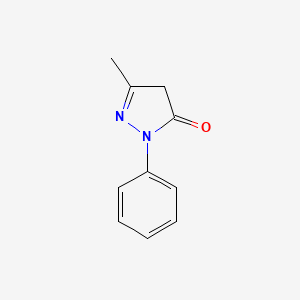


1. Mci 186
1. Mci 186
2. Edaravone
3. 89-25-8
4. 3-methyl-1-phenyl-2-pyrazolin-5-one
5. Radicut
6. Norphenazone
7. 1-phenyl-3-methyl-5-pyrazolone
8. Developer Z
9. Methylphenylpyrazolone
10. C.i. Developer 1
11. Norantipyrine
12. Phenyl Methyl Pyrazolone
13. Phenylmethylpyrazolone
14. Radicava
15. 3-methyl-1-phenyl-5-pyrazolone
16. 5-methyl-2-phenyl-2,4-dihydro-3h-pyrazol-3-one
17. 3-methyl-1-phenyl-1h-pyrazol-5(4h)-one
18. 1-phenyl-3-methyl-5-oxo-2-pyrazoline
19. 3-methyl-1-phenyl-2-pyrazoline-5-one
20. 3h-pyrazol-3-one, 2,4-dihydro-5-methyl-2-phenyl-
21. 5-methyl-2-phenyl-4h-pyrazol-3-one
22. 1-phenyl-3-methylpyrazolone
23. 2-pyrazolin-5-one, 3-methyl-1-phenyl-
24. Mfcd00003138
25. 1-phenyl-3-methylpyrazolone-5
26. Edaravone (mci-186)
27. 3-methyl-1-phenylpyrazol-5-one
28. Nci-c03952
29. 5-pyrazolone, 3-methyl-1-phenyl-
30. 2,4-dihydro-5-methyl-2-phenyl-3h-pyrazol-3-one
31. Colorex Pmp
32. Jarocol Pmp
33. Nsc-2629
34. 1-fenyl-3-methyl-2-pyrazolin-5-on
35. Nsc-26139
36. Chebi:31530
37. 3-methyl-1-phenyl-4,5-dihydro-1h-pyrazol-5-one
38. S798v6yjrp
39. Mls000069602
40. 3-methyl-1-phenyl-2-pyrazolin-5-one (mci-186)
41. Dtxsid9021130
42. Ci Developer 1
43. Ncgc00164015-01
44. Smr000059020
45. Edaravone [inn]
46. Dtxcid201130
47. Monopyrazolone
48. Wln: T5nmv Dhj Br& E1
49. Cas-89-25-8
50. Ccris 512
51. Radicut (tn)
52. Hsdb 4102
53. 3h-pyrazol-3-one,4-dihydro-5-methyl-2-phenyl-
54. Sr-01000000135
55. 1-fenyl-3-methyl-2-pyrazolin-5-on [czech]
56. Einecs 201-891-0
57. Unii-s798v6yjrp
58. Brn 0609575
59. Edaravona
60. 3-?methyl-?1-?phenyl-?2-?pyrazolin-?5-?one(edaravone)
61. Ai3-03557
62. Mci186
63. (edaravone)
64. Radicava (tn)
65. (mci-186)
66. Edaravone (standard)
67. Cds1_000986
68. Spectrum_000267
69. Tocris-0786
70. Edaravone [jan]
71. Mci-186; Edaravone
72. Edaravone [usan:inn]
73. Edaravone [hsdb]
74. Edaravone [usan]
75. Maybridge1_005738
76. Opera_id_1057
77. Spectrum2_001574
78. Spectrum3_000971
79. Spectrum4_001091
80. Spectrum5_001217
81. Norphenazone [mi]
82. M0687
83. Edaravone [mart.]
84. Ec 201-891-0
85. Edaravone [who-dd]
86. Schembl4704
87. Bspbio_001235
88. Bspbio_002601
89. Kbiogr_000575
90. Kbiogr_001502
91. Kbioss_000575
92. Kbioss_000747
93. Ae-641/00371017
94. Mls001146878
95. Mls002415675
96. Mls006011753
97. Divk1c_001018
98. Divk1c_002026
99. Schembl148321
100. Spectrum1503635
101. Spbio_001508
102. Chembl290916
103. Orb1310644
104. Schembl4099403
105. Schembl8935505
106. Schembl9439001
107. 1-pheny-3-methyl-5-pyrazolone
108. Edaravone (usan/jp17/inn)
109. Edaravone [orange Book]
110. Bcbcmap01_000127
111. Gtpl11994
112. Hms503k17
113. Hms557m18
114. Hy-b0099r
115. Kbio1_001018
116. Kbio2_000575
117. Kbio2_000747
118. Kbio2_003143
119. Kbio2_003315
120. Kbio2_005711
121. Kbio2_005883
122. Kbio3_001029
123. Kbio3_001030
124. Kbio3_001821
125. Nsc2629
126. Ninds_001018
127. 5-methyl-2-phenyl-2,4-dihydro-3h-pyrazol-3-one (edaravone)
128. Bcpp000246
129. Bio1_000438
130. Bio1_000927
131. Bio1_001416
132. Bio2_000448
133. Bio2_000928
134. Glxc-05042
135. Hms1362m17
136. Hms1792m17
137. Hms1990m17
138. Hms2234m19
139. Hms3266f04
140. Hms3403m17
141. Hms3411l05
142. Hms3654l15
143. Hms3675l05
144. Hms3884a11
145. Hms5079b11
146. Pharmakon1600-01503635
147. Bcp26336
148. Dzb76567
149. Hy-b0099
150. Nsc26139
151. Tox21_112077
152. Tox21_201747
153. Tox21_302819
154. Bdbm50200541
155. Ccg-39352
156. Msk000657
157. Nsc758622
158. S1326
159. Stk201315
160. 1-phenyl-3-methyl-2-pyrazolin-5-on
161. Akos000313817
162. Tox21_112077_1
163. Ac-4745
164. Bcp9000635
165. Cs-1832
166. Db12243
167. Fe22642
168. Nsc-758622
169. Sb19128
170. Idi1_001018
171. Idi1_002203
172. Ncgc00018218-01
173. Ncgc00018218-02
174. Ncgc00018218-03
175. Ncgc00018218-04
176. Ncgc00018218-05
177. Ncgc00018218-06
178. Ncgc00018218-07
179. Ncgc00018218-08
180. Ncgc00018218-10
181. Ncgc00018218-11
182. Ncgc00018218-17
183. Ncgc00022665-02
184. Ncgc00022665-04
185. Ncgc00022665-05
186. Ncgc00022665-06
187. Ncgc00256515-01
188. Ncgc00259296-01
189. St012744
190. Sy008808
191. Phenazone Impurity A [ep Impurity]
192. Sbi-0051836.p002
193. Db-002517
194. Ns00002708
195. Sw148216-2
196. 5-methyl-2-phenyl-2,4-dihydro-3-pyrazolone
197. En300-16234
198. 3-methyl-1-phenyl-2-pyrazoline-5-one, 99%
199. 4e-901
200. 5-methyl-2-phenyl-2,4-dihydro-pyrazol-3-one
201. D01552
202. D86209
203. 3-?methyl-?1-?phenyl-?2-?pyrazolin-?5-?one
204. Ab00375776_14
205. Ab00375776_15
206. 2 4-dihydro-5-methyl-2-phenyl-3h-pyrazol-3-one
207. 2,4-dihydro-2-phenyl-5-methyl-3h-pyrazol-3-one
208. Q335099
209. Sr-01000000135-2
210. Sr-01000000135-3
211. Sr-01000000135-5
212. 5-methyl-2-phenyl-2,4-dihydro-3h-pyrazol-3-one #
213. Brd-k35458079-001-04-2
214. Brd-k35458079-001-12-5
215. Brd-k35458079-001-23-2
216. Brd-k35458079-001-27-3
217. Brd-k35458079-001-28-1
218. Brd-k35458079-001-29-9
219. Brd-k35458079-001-31-5
220. Brd-k35458079-001-33-1
221. Z50145861
222. F0391-0021
223. 3-methyl-1-phenyl-2-pyrazoline-5-one, Saj Special Grade
224. 3-methyl-1-phenyl-2-pyrazoline-5-one, Purum, >=98.0% (nt)
225. Phenazone Impurity A, European Pharmacopoeia (ep) Reference Standard
226. Inchi=1/c10h10n2o/c1-8-7-10(13)12(11-8)9-5-3-2-4-6-9/h2-6h,7h2,1h
227. 2,4-dihydro-5-methyl-2-phenyl-3h-pyrazol-3-one;1-phenyl-3-methyl-1h-4,5-dihydropyrazol-5-one;methylphenylpyrazolone
| Molecular Weight | 174.20 g/mol |
|---|---|
| Molecular Formula | C10H10N2O |
| XLogP3 | 1.3 |
| Hydrogen Bond Donor Count | 0 |
| Hydrogen Bond Acceptor Count | 2 |
| Rotatable Bond Count | 1 |
| Exact Mass | Da |
| Monoisotopic Mass | Da |
| Topological Polar Surface Area | 32.7 |
| Heavy Atom Count | 13 |
| Formal Charge | 0 |
| Complexity | 241 |
| Isotope Atom Count | 0 |
| Defined Atom Stereocenter Count | 0 |
| Undefined Atom Stereocenter Count | 0 |
| Defined Bond Stereocenter Count | 0 |
| Undefined Bond Stereocenter Count | 0 |
| Covalently Bonded Unit Count | 1 |
Edaravone is indicated for the treatment of amyotrophic lateral sclerosis (ALS) in the US and Canada. It is also indicated to treat acute ischemic stroke in Japan.
Treatment of amyotrophic lateral sclerosis
Treatment of amyotrophic lateral sclerosis
Free Radical Scavengers
Substances that eliminate free radicals. Among other effects, they protect PANCREATIC ISLETS against damage by CYTOKINES and prevent myocardial and pulmonary REPERFUSION INJURY.
Neuroprotective Agents
Drugs intended to prevent damage to the brain or spinal cord from ischemia, stroke, convulsions, or trauma. Some must be administered before the event, but others may be effective for some time after. They act by a variety of mechanisms, but often directly or indirectly minimize the damage produced by endogenous excitatory amino acids.
N - Nervous system
N07 - Other nervous system drugs
N07X - Other nervous system drugs
N07XX - Other nervous system drugs
N07XX14 - Edaravone
Absorption
One study investigated the absorption of edaravone in healthy adults, who either received a single oral (105 mg/mL) or intravenous (60 mg/60 min) dose. The mean Cmax (CV%) and Tmax were 1656 (44.3) ng/mL and 0.5 hours, respectively, following oral administration. The absolute oral bioavailability is about 57% because of first-pass metabolism. The mean Cmax (CV%) and Tmax were 1253 (18.3) ng/mL and one hour, respectively, following intravenous administration. When intravenously administered, the maximum plasma concentration (Cmax) of edaravone was reached by the end of infusion. The Cmax and area under the concentration-time curve (AUC) of edaravone increases more than dose-proportional over the dose range of 30 to 300 mg. Edaravone does not accumulate in plasma with once-daily or multiple-dose administration. The Cmax and AUC decreased when the oral suspension formulation of edaravone was administered with a high-fat meal.
Route of Elimination
In Japanese and Caucasian healthy volunteer studies, edaravone was excreted mainly in the urine as its glucuronide conjugate (60-80% of the dose up to 48 hours). Approximately 6-8% of the dose was recovered in the urine as the sulfate conjugate, and <1% of the dose was recovered in the urine as the unchanged drug. _In vitro_ studies suggest that the sulfate conjugate of edaravone is hydrolyzed back to edaravone, which is then converted to the glucuronide conjugate in the kidney before excretion into the urine.
Volume of Distribution
After intravenous administration, edaravone has a mean volume of distribution of 63.1 L, suggesting substantial tissue distribution. Edaravone has an apparent volume of distribution of 164 L following oral administration. Edaravone readily crosses the blood-brain barrier.
Clearance
Following intravenous administration, the total clearance of edaravone is estimated to be 35.9 L/h. The apparent total clearance of edaravone is estimated to be 67.9L/h following oral administration.
The metabolites of edaravone have not been fully characterized. Edaravone is metabolized to a sulfate conjugate and a glucuronide conjugate, which are not pharmacologically active. The glucuronide conjugation of edaravone involves multiple uridine diphosphate glucuronosyltransferase (UGT) isoforms (UGT1A1, UGT1A6, UGT1A7, UGT1A8, UGT1A9, UGT1A10, UGT2B7, and UGT2B17). In human plasma, edaravone is mainly detected as the sulfate conjugate, which is presumed to be formed by sulfotransferases. Oral edaravone results in 1.3- and 1.7-fold higher exposures for both sulfate and glucuronide metabolites, respectively, when compared to intravenously-administered edaravone because of first-pass metabolism.
The mean terminal elimination half-life of edaravone is approximately 4.5 to nine hours. The half-lives of its metabolites range from three to six hours.
Oxidative stress and reactive oxygen species (ROS) production have been implicated in various neurological disorders, such as amyotrophic lateral sclerosis (ALS) and cerebral ischemia. Oxidative stress caused by excess ROS damages endothelial cells in the cerebral vasculature as well as neuronal cell membranes, leading to neuronal cell death. Edaravone is a free radical scavenger that scavenges and suppresses the generation of hydroxyl radicals and peroxynitrite radicals. The exact mechanism of action of edaravone in ALS has not been fully elucidated; however, edaravone is thought to mediate therapeutic effects via its antioxidant properties. Since oxidative stress has been implicated in the pathophysiology of ALS and cerebral ischemia, inhibiting lipid peroxidation, suppressing endothelial cell damage induced by lipid peroxides, and scavenging free radicals may lead to neuroprotective effects. Edaravone has no effect on superoxide production. It is suggested that edaravone may also possess anti-inflammatory properties, as it inhibited neutrophil activation and suppressed inducible nitric oxide synthase (iNOS) and neuronal nitric oxide synthase (nNOS) expression in animal models. It was also shown to ameliorate ROS-induced inflammatory oxidative stress after ischemic brain reperfusion.
BUILDING BLOCK


